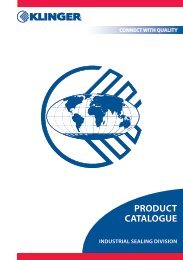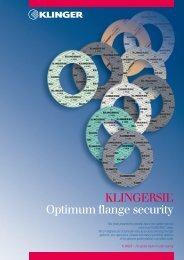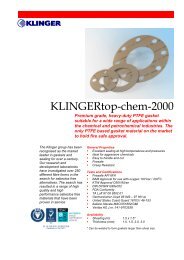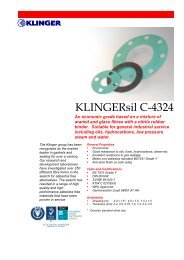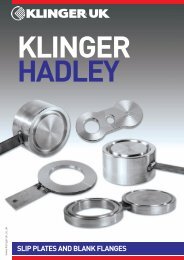to Download PDF 3.44MB - KLINGER Australia
to Download PDF 3.44MB - KLINGER Australia
to Download PDF 3.44MB - KLINGER Australia
Create successful ePaper yourself
Turn your PDF publications into a flip-book with our unique Google optimized e-Paper software.
KlingerNewsFebruary 2009www.klinger.chThe giant ball valve is here<strong>KLINGER</strong> Fluid Control GmbH, AustriaJosef Nahringbauer, MD <strong>KLINGER</strong> Fluid Control and Dr Thomas Klinger-Lohr, Chairman next <strong>to</strong> the gigantic <strong>KLINGER</strong> KHSVI ball valvewith a 1 meter diameter.To meet new demands from the marketplace, the managemen<strong>to</strong>f <strong>KLINGER</strong> Fluid Control has decided <strong>to</strong> extend its range oflarge-scale valves <strong>to</strong> include a size of DN 1000 (equaling an internaldiameter of 1000 mm). The ball valve has been developedin the company’s own R&D department using state-of-the-art,three-dimensional <strong>to</strong>ols and computer simulations, especiallyfor use in district heating networks.On 20 November 2008, <strong>KLINGER</strong>’sfirst ever ball valve of that size waslaunched by Dr Thomas Klinger-Lohr in thepresence of the entire Management Teamof <strong>KLINGER</strong> Fluid Control GmbH.As an environmentally friendly andcheap energy source district heating has
ecome established in many cities. Due <strong>to</strong>the rising energy costs, the scarcity of fossilfuels and the need <strong>to</strong> reduce CO 2emissionsin line with Kyo<strong>to</strong>, the expansion ofdistrict heating has been given <strong>to</strong>p priorrity.The continuing expansion of existingTechnical specificationsn Internal diametern Length1000 mm1981 mmn Height with gearbox and actua<strong>to</strong>r 2350 mmn Maximum body diametern Weightn Maximum working overpressure1715 mm9100 kg40 bardistrict heating networks demands largerpipelines and also correspondingly dimensionedshut-off equipment.<strong>KLINGER</strong> Fluid Control is nowable <strong>to</strong> meet these demandsManufacture of the first pro<strong>to</strong>typestarted in May 2008 and testing began inthe company’s own labora<strong>to</strong>ry in August2008. In the testing department, the valvewas checked out at maximum loads according<strong>to</strong> a pre-ordained series of tests. Pro<strong>to</strong>typetesting was brought <strong>to</strong> a succesfulconclusion at the end of Oc<strong>to</strong>ber 2008. Aninvestment of more than EUR 200,000 innew gantries, jigs, <strong>to</strong>ols, etc. was requiredbefore manufacture of the new ball valvewas feasible at the Gumpoldskirchen facility.<strong>KLINGER</strong> Fluid Control, based in Gumpoldskirchen(Vienna), has been a supplier ofspecial high-quality valves for the districtheating industry for more than 30 years.These valves are used not only in Austriabut also in district heating networks forexample in Moscow, St. Petersburg, Parisand Munich. <strong>KLINGER</strong> valves are knownthroughout the world for their reliability andlong service life. n2<strong>KLINGER</strong> BALLOSTAR for alternatingtemperature loads<strong>KLINGER</strong> Fluid Control GmbH, AustriaAt KF Fluid, our French sales representative, strategy rests ontwo important columns: product differentiation and focus. KFFluid has identified applications such as steam or hot water at160/180 °C where the KVN and BALLOSTAR ranges offer ourcus<strong>to</strong>mers superior tightness during service over a very longperiod of time. But sometimes success comes from unexpectedquarters - and MEG Mono Ethylene Glycol is one of them.MEG is used in many pharmaceuticalprocesses for cooling thermalfluids. The first BALLOSTARKHA SL VIII was installed in 1999 atSANOFI Aramon. MEG fluctuates from– 25 °C <strong>to</strong> + 150 °C at 10 bars with 1cycle every 8 hours, which is going <strong>to</strong>be very <strong>to</strong>ugh for any valve.Many valves from differentbrands have previouslybeen installed, but didnot give satisfaction <strong>to</strong>the end-user. However,thanks <strong>to</strong> its 3 pcs design and2 elastic sealing elements the <strong>KLINGER</strong>BALLOSTAR KHA can handle the changein temperature and stay tight in-line and<strong>to</strong> the outside. Because of the outstandingquality ofthe <strong>KLINGER</strong> BALLOS-TAR, the sealing elementsrequire changing every 4– 5 years only. Usually,the end-userwill buy a completebody becauseit is easier than sparesealing elements.New applications<strong>KLINGER</strong> Fluid ControlThe second and very successfulapplications meeting washeld at the Gumpoldskirchnerlocation in Oc<strong>to</strong>ber 2008 - akey event that was attendedby our trading partners fromWestern, Central and EasternEurope.
Since 1999, both SANOFI Aramon andSANOFI Sisteron have only been installingBALLOSTAR KHA SL VIII on MEG applications.Other cus<strong>to</strong>mers successfully usingKHA on MEG are: SOLVAY Tavaux, SOLVAYSalins du midi, FARCHIN, CHARABOT, andORSYMONDE. The next step for KF Fluidis <strong>to</strong> identify all pharmaceutical plantsthat use MEG in order <strong>to</strong> repeat the successachieved with SANOFI and otherend-users. n<strong>KLINGER</strong> technologies on the move<strong>KLINGER</strong> Limited, <strong>Australia</strong><strong>KLINGER</strong> Limited is proud <strong>to</strong> be associated with HIsmelt Corporationand their cutting-edge HIsmelt ® process technology.The HIsmelt ® process has beenspecially developed by Rio Tin<strong>to</strong> <strong>to</strong> treatiron ore fines with minimal raw materialpreparation using non-coking coals. It isvery flexible in terms of the qualities ofiron ore it can use - including high phosphorusores - and produces a premiumHIsmelt ® 860 mm Pressure Relief Valve(<strong>KLINGER</strong> gasket attached) being cranedup in<strong>to</strong> position.quality iron metallic for the marketplace.HIsmelt ® is a direct iron-making processin which iron ore fines and noncokingcoals are injected directly in<strong>to</strong> amolten iron bath <strong>to</strong> produce a quality moltenpig iron. It can be considered both asa potential replacement for the blast furnaceand as a new source of low-costiron units for the electric-arc steelmakingindustry. HIsmelt ® technology brings manyadvantages <strong>to</strong> the iron making industrysuch as low operating costs, low capitaloutlay, lower environmental impact, andgreater raw material and operational flexibility.HIsmelt ® technology is ready <strong>to</strong> belicensed worldwide.The world’s first commercial HIsmelt ®plant is located in Kwinana, Western <strong>Australia</strong>.Owned jointly by Rio Tin<strong>to</strong>, NucorCorporation, Mitsubishi Corporation andShougang Corporation, construction commencedin January 2003 with hot commissioningbeginning in April 2005.Currently, there are two other licenseeswho have signed up for the HIsmelt® process: the Laiwu Steel Group Limitedand the Nanjing Iron and Steel GroupJiangsu Huaigang Corporation Limited,both from China .The licences entitle thesegroups <strong>to</strong> develop an iron-making facilityusing world-beating HIsmelt ® technology.Under the agreements, the groups willbe able <strong>to</strong> replicate the 800,000 <strong>to</strong>nnesper-yearoutput of the Kwinana HIsmelt ®plant. n3The two-day meeting is aimed primarilyat an exchange of experience between<strong>KLINGER</strong> Fluid Control as a manufacturerand its trading partners. A <strong>to</strong>tal of 32 tradingpartners from 21 countries <strong>to</strong>ok part inwhat has now become a favorite event. Thisyear, <strong>to</strong>o, was an opportunity <strong>to</strong> tell participantsabout several new applications, makingit very much easier for them <strong>to</strong> identifynew markets for high-quality <strong>KLINGER</strong>valves. <strong>KLINGER</strong> Fluid Control products arehighly appreciated throughout the world fortheir excellent quality, broad range of applications,long service life and low maintenanceand life cycle costs. In addition <strong>to</strong>many new and interesting applications, thehighlight of the event was without doubtthe presentation of the new DN 1000 sizedvalve in our BALLOSTAR range. During a12 bar saturated steam test, participantswere able <strong>to</strong> see for themselves just howthe new product performs. With a furtherpro<strong>to</strong>type currently «in the pipeline»,series production is scheduled from thebeginning of 2009.Thanks <strong>to</strong> the great success of theseapplication meetings, we are pleased <strong>to</strong>announce that further events are beingplanned for Asia, America and Africa forthe current year. n
<strong>KLINGER</strong><strong>to</strong>p-chem-2000The pressure resistant PTFE material for narrow-section gaskets<strong>KLINGER</strong> GmbH, Germany4Typical applications can be found inthe plumbing and heating sec<strong>to</strong>r, in otherwords with water as the medium and amaximum temperature of approximately86 °C. But threaded unions are alsoused in gas supply. In industrial plant andmachine <strong>to</strong>ol construction, supply linesfor water, nitrogen, oxygen, fuel gas, andalso oil, heating media and coolants, areoften closed off using threaded unions.Threaded unions are also one of the fittingsused for connecting solar collec<strong>to</strong>rs,where the temperature of the heattransfer medium can exceed 180 °C, <strong>to</strong>the pipe system.Threaded unions with flat gaskets arethus exposed <strong>to</strong> the most varied media,temperatures and stresses.The Behavior of threaded unionsincorporating flat gasketsTwo different types of threaded union canbe examined:n Connection of a male and a femaleend using a screw-thread connection,where the two sealing surfacesare rotated in opposite directions whenfitting.n Connection of two components withflanged sealing surfaces using a unionnut, with manual resistance eitherreducing or preventing rotation of thesealing surfaces (Fig. 1).A look at the special requirements for achieving a leak-freeseal with narrow-section gaskets - for example in threadedunions - reveals that although these connections have been inuse for many decades, problems are always reoccurring in anumber of application areas.A common feature of both types is theconnection’s relatively rigid behavior. Thiscan best be explained with a contrastingexample - a flange connection (Fig. 2) -where the long bolts and the flange platehave a sprung effect.Fig. 2: Flange connection with spring componentsIn the case of a loss of thickness ofthe gasket (e.g. through heat-relaxation),spring action will result in the maintenanceof some degree of surface pressure- and thus sealing effect and mechanicalstability.With a threaded union, only the pipeor the tensioned section of the union nutcan be regarded as a sprung element,although it’s clear that component lengthsof only a few millimeters are involved.In the illustration (Fig. 3), below it can beseen that the length of the portion undertension merely equates <strong>to</strong> the thicknessof the gasket plus the flange on the righthandcoupling. The connection surface ofthe union nut can also flex slightly.In practice, the options for compensatinga possible loss of thickness arevery restricted.A further problem with threadedunions is the width of the gasket. Often,the actual sealing width is merely the wallthickness of the component (pipe). Inthis situation, wider gasket rings merelyappear more secure. Moreover, dependingon the component, damage can becaused <strong>to</strong> the ring gasket during assembly,while rotational movement during assemblycan also lead <strong>to</strong> considerable shearstresses. And with assembly often beingcarried out using pump pliers, a specific<strong>to</strong>rque loading cannot be relied on and theresultant forces can varyconsiderably.Fig. 1: Typical screw connectionGasket + Nipple = approx. elastic lengthFig. 3: Elastic component length of a threaded connection
The requirements on thegasket materialThe types of stress described above meanthat special demands are placed on thegasket material. They include:n Low shrinkage, even under temperaturestress, in order <strong>to</strong> maintain thesealing forces.n Edge stability, despite unfavorable ringwidth (thickness/width ratio)n Resistance <strong>to</strong> shear or frictionalforces arising from possible relativemotion of the gasket surfaces duringassembly.Additionally:n The gasket material must be able<strong>to</strong> conform <strong>to</strong> the seal counterpart(metal surfaces are standard) sothat no leaks occur on the contactsurfaces.n The sealing material must also beimpermeable, so that this leakageroute is also eliminated.The sealing sequenceIn the case of standard ring gaskets madefrom soft fibrous materials (filler, fibers,elas<strong>to</strong>mer as the binder), the sealing processensues as follows:The gasket is pressed:n It adapts <strong>to</strong> the surfaces of the sealingcounterpart and seals the contactsurfaces.n In so doing, the cross section of thegasket is placed under mechancalpressure and the existing capillariesand cavities are closed.n This process requires a certain time,however, and is associated with a lossof thickness in the gasket.On first heating, the gasket materialagain becomes slightly softerand resets - with additional loss ofthickness.If, therefore, higher demands are <strong>to</strong> beplaced on the security of the threadedunion, also from a temperature andduration point of view, standard materialsare no longer able <strong>to</strong> satisfy thesedemands.The alternativesWhich gaskets can be seen as alternatives,and how are they <strong>to</strong> be assessed?n Rubber gasket rings - these are veryimpermeable and have an excellentability <strong>to</strong> adapt; nevertheless, theypossess low stability when faced withhigher demands relating <strong>to</strong> temperatureand screw forces.n Metal gasket rings - these arevery stable and impermeable, butadapt insufficiently <strong>to</strong> the sealingsurfaces.n Pure graphite gasket rings - thesehave very high adaptability, but are<strong>to</strong>o fragile during assembly and copebadly with the unfavorable thickness/width ratios.n PTFE gasket rings - these exhibit highconformability and are impermeablebut standard materials still possessexcessive flow properties.5Rich. <strong>KLINGER</strong> Ind e Com Ltda., Brazil<strong>KLINGER</strong> GmbH lectures at the 15 thInternational Sealing Conference<strong>KLINGER</strong> GmbH <strong>to</strong>ok advantage of the 15 th ISC in Oc<strong>to</strong>ber 2008 in Stuttgart<strong>to</strong> showcase their PTFE gasket materials and <strong>to</strong> lecture on the stabilityof PTFE-material for narrow gaskets. Sales Manager Norbert Weimer, KLIN-GER GmbH, presented the latest results of research and development andthe experiences of applications in practice for <strong>KLINGER</strong><strong>to</strong>p-chem-2000.The prospects for PTFE gaskets aretherefore exrtremely good if the problemsassociated with flow characteristics canbe solved.The following features and measurementswill allow an evaluation of the flowcharacteristics:n Compressibilityn Residual surface pressure on thegasket after temperature cycling
We can create subgroups according <strong>to</strong>compressibility:Subgroups according <strong>to</strong> compressibilityn Compressibility < approx. 3 % High grade PTFE Very suitablen Compressibility approx. 5 –10 % Medium grade PTFE Suitable with conditionsn Compressibility approx. 15 – 30 % Soft PTFE Hardly suitablen Compressibility > approx. 50 % Expanded PTFE Unsuitable6The remaining residual surface pressureafter temperature cycling is a measureof the longterm stability of gasketmaterials. If the gasket material continues<strong>to</strong> flow, the residual surface pressurewill be lower.PS10 solar power <strong>to</strong>werExperience from practicalapplicationsA user of a <strong>KLINGER</strong><strong>to</strong>p-chem-2000high-grade material has run a test <strong>to</strong> selectthe correct gasket material, and has beengenerous enough <strong>to</strong> make the resultsavailable <strong>to</strong> us. This particular applicationwas in the area of chemical pumps.The vent and drain plugs in these pumpsare mostly equipped with narrow ring gaskets(Fig. 4). However, because there is arequirement for the universal use of sealingmaterials in the chemical industry,PTFE is the correct basis.Test structure: non-grooved 120 ×112 mm ring gasket, <strong>to</strong>rque 40 Nm, equivalent<strong>to</strong> 15.8 N/mm².Test cycle: 5 temperature cyclesfrom 20 – 120 °C over a <strong>to</strong>tal of 110 hours.Measurements: thickness of the gasketbefore and after the measuring sequence,and remaining residual <strong>to</strong>rque.The measurement results are summarizedin the following diagrams. Notethat material of equal thicknesses wasnot available. The results have thus beenstandardized <strong>to</strong> a thickness of 1 mm (linear).The original thicknesses are listedfor information purposes.In the first diagram (Fig. 5) it can beseen that, after the temperature cycles,minimal thickness loss was experiencedon high-grade material only.50,0045,0040,00From the Lossof Torque diagram(Fig. 6) it can beseen that becauseof low loss of thickness during the temperaturecycles, the loss of <strong>to</strong>rque is also atits lowest. Note that the linear standardizationof the results does not correspond<strong>to</strong> reality, and thinner original thicknessesalways come out with a better evaluation.Because the high-grade material is one ofthe thicker ones, the results can thereforebe seen as especially positive. In reality,for assembly reasons, gaskets between 2mm and 3 mm are mostly used, as in thechemical pump with the threaded plugs(Fig. 7). The significance of the results andthe differences between materials are thusall the more distinct.Ergebnisse Dickenverlust in % / result thickness loss in %nach Einbau normiert auf 1mm Dicke (linear) /after mounting standardised <strong>to</strong> 1mm thickness (linear)nach Testzyklus normiert auf 1mm Dicke (nur warmverf.) / after testcycle standardused <strong>to</strong> 1mm thickness (only hot compression)35,0030,00%25,0020,0015,0010,005,000,00Material 1 Material 2 Material 3 Material 4 Material 5 Material 6 Material 7 High-Grade-MaterialMaterial 8 Material 9Fig. 4: Pumps with vent & drain plugsFig. 5: Loss of thickness results70,00Verlust an Drehmoment, normiert auf 1 mm Dicke (linear) /loss of <strong>to</strong>rque, standardised <strong>to</strong> 1 mm thickness (linear)60,00
%%50,0045,0040,0035,0030,0025,0020,0015,0010,005,000,0070,0060,0050,0040,0030,00The test results clearly show that,for plug gaskets with a cross section ofapprox. 2 × 2 mm, only a gasket materialwith high-grade properties can be considered,because this is able <strong>to</strong> maintainthe residual surface pressure.Ergebnisse Dickenverlust in % / result thickness loss in %nach Einbau normiert auf 1mm Dicke (linear) /after mounting standardised <strong>to</strong> 1mm thickness (linear)nach Testzyklus normiert auf 1mm Dicke (nur warmverf.) / after testcycle standardused <strong>to</strong> 1mm thickness (only hot compression)Further applications for high-resistance<strong>KLINGER</strong><strong>to</strong>p-chem 2000 withthreaded unionsIn addition <strong>to</strong> the examples describedin the above, the special advantages of thematerial are shown on the basis of furtherMaterial 1 Material 2 Material 3 Material 4 Material 5 Material 6 Material 7 High-Grade- Material 8 Material 9Materialapplications:Verlust an Drehmoment, normiert auf 1 mm Dicke (linear) /loss of <strong>to</strong>rque, standardised <strong>to</strong> 1 mm thickness (linear)accompanied by a desire <strong>to</strong> extendthe inspection intervals <strong>to</strong> 5 yearsalong with great uncertainty thatleaks may not be discovered promptly.Tests were therefore run on the mostvaried solutions, and the <strong>KLINGER</strong><strong>to</strong>p-chem-2000material was thenused.n In the case of solar collec<strong>to</strong>r installations,the threaded unions weresometimes exposed <strong>to</strong> very hightermperatures. Here, <strong>to</strong>o, the stabilityof the gasket material was in thecritical conditions within the union.Resistance <strong>to</strong> changes in temperatureand the absence of material ageingare further key fac<strong>to</strong>rs in favor ofthis material, in addition <strong>to</strong> the stabilityof the connection.7mm20,0010,000,001,41,210,80,60,40,20Material 1 Material 2 Material 3 Material 4 Material 5 Material 6 Material 7 High-Grade- Material 8 Material 9MaterialAusgangsdicke (zur Information) / origin thickness (for information)1,241,111,11 1,11,03 1,03 1,04Fig. 6: Flange connection with spring componentsFig. 7: Plug with gasket ring of <strong>KLINGER</strong><strong>to</strong>p-chem-2000with a cross section of 2.1mm in width and 2.0 mm in thickness.0,70,850,49n In the district heating substations ofa well-known German energy supplier,the threaded unions are sealedby high-grade PTFE material alone.After a three-year test phase andwith experience now adding up <strong>to</strong>more than 10 years, the results areso positive that no further risk isdeemed <strong>to</strong> exist. Previoulsy, servicepersonnel inspected all stations andwere required <strong>to</strong> check the tightnessof the connections in the distributionnetwork on an annual basis. Conversion<strong>to</strong> fully insulated stations wasExperience gained thus far showsthat, with high-performance gasket andsealing materials based on pressureresistantPTFE gasket materials, it is possible<strong>to</strong> extend the limites governing theuse of threaded unions incorporatingsecurity. <strong>KLINGER</strong><strong>to</strong>p-chem-2000 is theonly PTFE gasket material in this performanceclass, and can be obtained fromany good dealer. n
<strong>KLINGER</strong>SIL ® C4265 -a soft solution <strong>to</strong> a hard problemRich. <strong>KLINGER</strong> Dichtungstechnik GmbH & CoKG, Austria8A review of the latest documentsissued by law makers and NGOs <strong>to</strong> dealwith pollution related issues on the technicallevel shows that gaskets are alsoimpacted by the requirements. A verydirect example is when application engineersare asked <strong>to</strong> provide assistance <strong>to</strong>a cus<strong>to</strong>mer and recommend the mosteffective sealing material for a given servicesituation. The demands can be summarizedas follows:n High tightnessn Low bold forcesn Universal chemical resistancen Uneven and/or rough surfacesn Temperatures up <strong>to</strong> 250°C/500 °FMany sealing applications imposethese requirements, especially in theOEM market. The consultant engineerwill consult the <strong>KLINGER</strong> Product Catalogueof Gasket Materials in order <strong>to</strong>identify a grade that can satisfy the cus<strong>to</strong>mer’srequirements. A look through thecatalogue will reveal a number of NBRbasedgrades that could meet the specification- with the exception of tightnessat low loads, because these grades showlow compressibility. A further search for agrade with high compressibility will locatean SBR grade. Unfortunately, however, thisgrade is not chemical resistant, and servicetemperature is critical. What now?In order <strong>to</strong> provide a «missing link»solution, <strong>KLINGER</strong> Dichtungstechnik hasdeveloped <strong>KLINGER</strong>SIL ® C4265. This isan NBR-based, synthetic fiber-reinforcedsheeting material designed for use inapplications where superior tightnessat low bolt forces is required. <strong>KLINGER</strong>-SIL ® C4265’s high compressibility leadsBecause new regulations and directives are increasinglyfocused on pollution prevention, the tightness of joints iscurrently the subject of reappraisal. Application engineersare now confronted more frequently with requirements likeexcellent tightness with low bolt forces and universal chemicalresistance. It is precisely these criteria that apply <strong>to</strong> many OEMapplications. So far, no <strong>KLINGER</strong>SIL ® grade has been able <strong>to</strong>meet them in full. However, <strong>KLINGER</strong>SIL ® C4265, the latestdevelopment from <strong>KLINGER</strong> Dichtungstechnik, has beendesigned specially for such applications. And a comprehensiverange of tests has demonstrated the potential of the new gradeand its unparalleled features.<strong>to</strong> the excellent surface sealing experiencedwith common SBR materials, butwith the tried-and-tested stress resistanceand chemical compatibility of NBR materials.<strong>KLINGER</strong>SIL ® C4265 is suitable foruse in liquid and gaseous media such asoils, hydrocarbons, solvents, water, refrigerantsand many other substances attemperatures up <strong>to</strong> 250 °C/500 °F. Thematerial is dark blue on both sides, with agrayish center.Having now identified <strong>KLINGER</strong>SIL ® C4265as a suitable material, the applicationengineer will start <strong>to</strong> check the cus<strong>to</strong>mer’srequirements against a special set ofproperties:Superior tightness at low boltforces: <strong>KLINGER</strong>SIL ® C4265 has demonstratedits excellent tightness during testswith fluids, nitrogen and helium. For example,<strong>to</strong> seal 40 bar of helium at a tightness
of 0.01 mg/m*s, all that’s required is a10 MPa load! What’s more, a tightnessof 0.0000001 mg/m*s can be achievedsimply by increasing the load under thesame conditions. In-house lab tests haveshown that <strong>KLINGER</strong>SIL ® C4265 complieswith the requirements of the German AirPollution Directive (TA-Luft).The most striking effect of <strong>KLINGER</strong>-SIL ® C4265’s high compressibility is thematerial’s ability <strong>to</strong> compensate for unevenfaces even under very low loads, asemphasized and evaluated by a series ofso-called «Out of Flatness Tests».For this test, a gasket is assembledbetween a steel and a glass plate undergasket. ASTM Oil IRM 903, for example,is allowed <strong>to</strong> impinge under pressure onthe inner diameter of the gasket, and thewhole test fixtures is heated in order <strong>to</strong>simulate service conditions. By lookingthrough the glass plate, it is possible <strong>to</strong>observe how the gasket creates a sealalong the groove.9Applicable on rough and/or unevensurfaces: It’s widely known thatthe compressibility of a sheeting materialindicates its ability <strong>to</strong> adjust <strong>to</strong> criticalsurfaces. The compressibility of standardmaterials varies between 5 and 12 %.Compared with existing state-of-the-artproducts, <strong>KLINGER</strong>SIL ® C4265 shows acompressibility in the region of 30 %. Thisexceptional property enables the material<strong>to</strong> adapt <strong>to</strong> irregular sealing faces. Acomparison of a Shore Hardness of 40for <strong>KLINGER</strong>SIL ® C4265 with the averagehardness of approximately 65 for standardgrades underlines the adaptability ofthe new product.a load of 10 MPa. To simulate an unevensealing face on the steel plate, aradial groove with a defined geometry ismilled on<strong>to</strong> the face in contact with the
The following Fig. 1 and Fig. 2 illustrate thesealing properties of a standard materialcompared <strong>to</strong> <strong>KLINGER</strong>SIL ® C4265.the formulation and raw materials havebeen designed <strong>to</strong> obtain a gasket thatis also suitable for contact with variousachieve a well-balanced pressure/temperaturerating.After digesting all this information10Fig. 1 Fig. 2Note the left-hand test fixture (Fig. 1)sealed with <strong>KLINGER</strong>SIL ® C4265 (blue).This shows no penetration of the mediaalong the groove. Due <strong>to</strong> its superior flexibilityand compressibility, the material isable <strong>to</strong> fill the space of the reduced crosssection of the steel plate and prevent leakage.The right-hand test fixture (Fig. 2),on the other hand, has been sealed witha reference material (green), which hasa compressibility of about 10 %. Underidentical test conditions, this materialshows insufficient compressible deformation<strong>to</strong> prevent media from passingalong the groove.refrigerants. Extraction tests with representativerefrigerants have demonstratedthe suitability of <strong>KLINGER</strong>SIL ® C4265, anda separate chemical compatibility chartcan be forwarded on request.Acceptable load bearing propertiesat elevated temperatures are not contradic<strong>to</strong>ry<strong>to</strong> high compressibility. Thanks<strong>to</strong> a sophisticated formulation of rubber,fillers and fibers, it has been possible <strong>to</strong>100908070p-T-rating <strong>KLINGER</strong>SIL® C42653and reviewing his request form, whatwill the application engineer discover? Atick against each and every requirement!Having now found the perfect solution,all that’s left <strong>to</strong> do is <strong>to</strong> call the cus<strong>to</strong>merand say: ”Use <strong>KLINGER</strong>SIL ® C4265. It willwork for sure!” nFor more information, please visit www.klinger.co.at, or contact piringer@klinger.co.atUniversal chemical and temperatureresistance up <strong>to</strong> 250 °C/500 °F:Because <strong>KLINGER</strong>SIL ® C4265 is basedon NBR as a binder, it is a non-swellinggrade. When it comes <strong>to</strong> chemicalresistance, it compares with other NBRmaterials in the <strong>KLINGER</strong>SIL ® C range. Inaddition <strong>to</strong> a basic chemical resistance,p [bar]605024030201100-200 -150 -100 -50 0 50 100 150 200 250 300 350temperature [°C]
AES operates 9 power plants with an installed capacity of 2,828 megawatts - or approximately 10 % of the <strong>to</strong>tal installed capacityin Argentina. It has two distribution companies, EDELAP and EDES, serving more than 460,000 cus<strong>to</strong>mers.11A seal of approval from AES AlicuraRich. <strong>KLINGER</strong> S.A.A.C.I.yF., ArgentinaA problem solved - AES Corporation is one of the world’slargest energy concerns. Operating in 29 countries and on 5continents, AES generating plants and distribution companiessupply energy <strong>to</strong> 100 million people. In 2007, sales <strong>to</strong>pped USD13,600 million.At the beginning of 2006, Rich.<strong>KLINGER</strong> Argentina received an enquiryfrom AES Alicura regarding a fault withJIS standard spiral wound gaskets (in AISI316 stainless steel with graphite filler) suppliedby competi<strong>to</strong>rs. These gaskets werecausing a leak in the refrigeration duct ofa Mitsubishi 701 gas turbine, where airwas at 460 °C and 16 bars. Replacemen<strong>to</strong>f the damaged gasket required the gasturbine <strong>to</strong> be taken out of service and thewhole operation <strong>to</strong>ok approximately 10hours. Normal operations require regularshutdowns and start-ups with correspondingexpansion and contraction inthe pipes. The faulty gasket showed afracture on the centering ring as well asdis<strong>to</strong>rtion on the spiral-wound body. DrTeodorico Lythgoe, Technical Direc<strong>to</strong>r atRich. <strong>KLINGER</strong> Argentina, and Mark Williamsof <strong>KLINGER</strong> Ltd, UK, concluded thatbecause of the high temperatures of thisapplication, gaskets with <strong>KLINGER</strong> MaxiflexZonal mica/graphite/mica filler shouldbe used. Spiral-wound gaskets with micaand graphite offer excellent resistance <strong>to</strong>high temperature applications. The micaacts as a barrier and insulates the graphiteagainst possible oxidation. ”We havebeen using this type of gasket since 2006without air leakage”, say maintenance personnelat AES Alicura, and thus give KLIN-GER their seal of approval! During the lastplant shutdown, AES replaced the set of<strong>KLINGER</strong> gaskets as a scheduled maintenancemeasure. After 8000 hours of use,the company was able <strong>to</strong> confirm theirperfect condition. Ten turbine shutdownsand start-ups were scheduled during thisperiod, each accompanied by the risk ofa leak, but the <strong>KLINGER</strong> Maxizonal mica/graphite/mica gaskets s<strong>to</strong>od up <strong>to</strong> theconditions easily, safely and reliably.AES ArgentinaWith capital expenditure exceedingUSD 1 billion since it started its operationsin 1993, AES Argentina is one ofthe three main inves<strong>to</strong>rs in the electricitysec<strong>to</strong>r in Argentina and the largest fromthe United States.AES AlicuraThe Alicura Dam is the first of fivedams on the Limay River in the northwes<strong>to</strong>f the Comahue region on the borderbetween the provinces of Neuquenand Rio Negro, Argentina. With an installedcapacity of 1,050 MW, it was acquired byAES in August 2000. n
Small is the new bigRich. <strong>KLINGER</strong> Ind e Com Ltda, BrazilThe new compact actuated control valve is lighter, easier <strong>to</strong>install, and consumes less compressed air.12The Brazilian market already knowsthat Richard <strong>KLINGER</strong> offers technicallyadvanced products that come with realreductions in operating costs for the generationand distribution of steam, compressedair and other industrial fluids.Until now, <strong>KLINGER</strong> has supplied themarket with an actuated control valve thatthanks <strong>to</strong> its high durability and reliability,has achieved considerable success. Withthousands of units installed all over theworld, this valve is recognized by users asa design that combines outstanding performance,the safety of a globe valve witha pis<strong>to</strong>n sealing system, and the efficiencyof an actua<strong>to</strong>r using a pneumatic springand no diaphragm.Now, <strong>KLINGER</strong> is extending its productline by offering a new compact actuatedglobe control valve. This is the secondgeneration of a product with qualitiesthat are already acknowledged by the market.It comes with additional advantagesfor industrial control operations, includingthe control of termperature, pressure,flow and level.Manufactured entirely in injectionmoldedaluminium, this new actua<strong>to</strong>r isfar lighter and smaller, making it easier<strong>to</strong> install and handle and facilitating thedesign of the piping.Despite its compact size (approximately40 % less than the previous<strong>KLINGER</strong> actua<strong>to</strong>r), the new KVA actua<strong>to</strong>rretains the classic advantage of all<strong>KLINGER</strong> actua<strong>to</strong>rs: it uses a maintenance-free,pneumatic spring in place ofa diaphragm.This actua<strong>to</strong>r allows the new KLIN-GER control valve <strong>to</strong> carry out on/off controloperations in diameters of ½” <strong>to</strong> 2” andat pressures of 0 <strong>to</strong> 40 bar with almostany type of fluid. This means that a singleactua<strong>to</strong>r can be used for the three sizesThe very latest in actua<strong>to</strong>rtechnologyAlways attuned <strong>to</strong> the needs ofthe industry, <strong>KLINGER</strong> has developed asmaller product that will help its cus<strong>to</strong>mersdecrease the time and cost of installation,operation and maintenance. That’sbecause the <strong>KLINGER</strong> compact controlvalve introduces a new concept in controlvalves. Its main feature is the new,surprisingly compact, light and modernKVA actua<strong>to</strong>r.New compact actuated control valve: small, light, attuned <strong>to</strong> the needs of the industry.Principal advantages of the new valve:n Light and super-compact actua<strong>to</strong>rn A single actua<strong>to</strong>r for dimensions between ½” and 2”n Faster response and lower consumption of compressed airn Class VI leakage level for temperatures up <strong>to</strong> 400 °Cn Easier <strong>to</strong> install, operate and maintain
Sustainabilityn The compact <strong>KLINGER</strong> valve supports the new concept of preventinglosses and decreasing emissions of pollutants in<strong>to</strong> the atmosphere.of actua<strong>to</strong>r previously used in the ½” and2” range. In other words, the actua<strong>to</strong>r ona DN 50 valve can also be used on a DN15, thus simplifying s<strong>to</strong>cking.Previous actua<strong>to</strong>r and the new KVA model:a 30 <strong>to</strong> 50 % decrease in dimensions.Food companies, textile companies,machine-<strong>to</strong>ol manufacturers and sugar/alcohol refineries are among the usersthat have already installed the new compact<strong>KLINGER</strong> control valve. Like its predecessor(which is still available in diametersbetween 2 ½” and 8”), the new compact<strong>KLINGER</strong> valve can be used in liquids, gassesand steam. On/off and control functions(flow rate, pressure and temperature)are combined in the same valve.Surprising dimensionspromote savingsThe innovative design of the compact<strong>KLINGER</strong> valve can best be appreciatedwhen compared with the previousmodel for applications with diametersbetween ½” and 2”. The weight hasbeen decreased from 18 kg <strong>to</strong> approximately5 kg. There’s also an impressivedrop in size: the height of the new actua<strong>to</strong>ris down by 30 %, while the diameteris down approximately 50 % (an especiallyimportant fac<strong>to</strong>r for machine-<strong>to</strong>oland equipment manufacturers).Thanks <strong>to</strong> the new dimensions,response times are faster and compressedair consumption is also improved: with thenew 2” compact valve, for example, it ispossible <strong>to</strong> reduce compressed air consumptionby more than 90 %. But that’snot all: installation and maintenance aremuch faster - with the quick connectionsystem enabling rapid assembly and dismantling- and because the actua<strong>to</strong>r isnow much lighter, lifting tackle is a thingof the past. Furthermore, the positioningcomponent is now installed directly onthe actua<strong>to</strong>r, thus eliminating the needfor adap<strong>to</strong>rs or fittings. n13Reliable for industry, safe for the environmentThe KXGT graphite seals employedin the compact <strong>KLINGER</strong> valve guaranteethat the unit has Class VI leakage.As a key <strong>KLINGER</strong> feature, KXGT graphiteseals prevent the emission of chemicalsin<strong>to</strong> the atmosphere and the subsequentloss of valuable and/or corrosivefluids for users.KXGT graphite seals also meangreater energy efficiency, with lesssteam loss, less waste, and less consumptionof fuels such as natural gasand oil. Because the contact is metalgraphiterather than metal-metal, the«soft» technology of the graphite ringsguarantees a 100 % seal.A further advantage of the compact<strong>KLINGER</strong> valve is that its lanternsare specially dimensioned <strong>to</strong> suit eachapplication in order <strong>to</strong> control the glowcoefficient in line with each process.Another key feature of the newproduct is the quick connection systemthat enables the valve and actua<strong>to</strong>r<strong>to</strong> be separated for maintenance ofthe two components (valve and actua<strong>to</strong>r).Moreover, in conventional valves,depending on the working pressure, itmay be necessary <strong>to</strong> open the actua<strong>to</strong>rand replace the springs. But thecompact <strong>KLINGER</strong> valve functions wellbetween 0 and 40 bar, with no need <strong>to</strong>replace the springs.With a body assembled from highstrength materials (carbon steel or stainlesssteel), the compact <strong>KLINGER</strong> controlvalve is ideal for incorporation in<strong>to</strong>new line layouts or the replacement ofvalves that have reached the end oftheir service life. Once again, <strong>KLINGER</strong>has launched yet another product thatmeets the company’s standards in full:namely, high quality and high strength,in addition <strong>to</strong> the Class VI leakagealready mentioned. nTo find out more about this compactvalve, phone (11) 4596-9514, ore-mail: rkvendas@rklinger.com.br.
Success and recognition for SAIDI atExpoquimio ‘08SAIDI, SpainExhibi<strong>to</strong>rs and visi<strong>to</strong>rs alike expressed their complete satisfactionat the close of 2008’s three Fira de Barcelona shows - Expoquimia,Eurosurfas and Equiplast - which are staged at theGran Via Exhibition Center and make up the Mediterraneanregion’s largest applied chemistry event.14Expoquimia with its special focus onbiotechnology and nanotechnology featureda host of commercial and scientificofferings plus a large variety of products,solutions and new technological applicationsthat will help define the future of achemical sec<strong>to</strong>r that is increasingly committed<strong>to</strong> sustainability and environmentalcare. Expoquimia also highlighted thesec<strong>to</strong>r’s commitment <strong>to</strong> sustainability withLab&Bio, a special exhibition zone whereover 7,500 square meters of exhibitionspace were assigned <strong>to</strong> biocompanies,and Compositech, which is dedicated<strong>to</strong> new materials.Eurosurfas and Equiplast also promotedthe use of more eco-friendly products,both in surface treatment technologyand in the manufacture of plastics.At Equiplast, the plastics sec<strong>to</strong>r calledfor a renewal scheme <strong>to</strong> replace currentproduction machines with new andcleaner equipment.With speakers like Japanese scientistYoshinobu Baba, who predicted thatwithin five years nanotechnology will beapplied in the early detection of the initialstages of cancer, and Kurt Wüthrich,the Nobel Prizewinner in Chemistrywho is studying the composition of theSARS virus, Barcelona also became thecentre of scientifc debate.A rise in foreign visi<strong>to</strong>rsProvisional estimates show that thethree shows organized by Fira de Barcelonawere visited by over 55,000 professionals.The rise in the number of foreignvisi<strong>to</strong>rs is estimated at approximately10 %. With a <strong>to</strong>tal of 1,100 direct exhibi<strong>to</strong>rsand over 2,000 visi<strong>to</strong>rs attending thefull program of seminars and congresses,Direc<strong>to</strong>r of Expoquimia, Eurosurfas andEquiplast Pilar Navarro was upbeat inhis assessment of this year’s shows, statingthat they «equaled the 2005 figuresdespite the current economic climate”.SAIDI launches its new corporateidentityTo coincide with this important Internationaland European trade show, SAIDIappeared with a new, state-of-the-artstand that promoted its new corporateidentity and logo. Our suppliers made surethat <strong>KLINGER</strong> was represented by a widevariety of product samples.With clients and suppliers beinggreeted <strong>to</strong> our stand by salsa rhythmsand a glass of moji<strong>to</strong>, a typical Caribbeandrink, we always knew we couldcount on the invaluable assistance of ourBarcelona branch! All of its members -from both front and backoffice - bent overbackwards <strong>to</strong> make it possible. Our successwas entirely due <strong>to</strong> them. So thanks<strong>to</strong> all! n
SAIDI attends WorldPetroleum Congress in MadridSAIDI, SpainThe World Petroleum Congress staged in Madrid between 28June and 3 July, 2008, has earned its reputation as the «Olympicsof the oil and gas industry».This year, at the 19 th World PetroleumCongress, the Congress Program Committeeprepared a wide-ranging technicalprogram <strong>to</strong> acknowledge scientific,technological and professional achievementsin the petroleum industry andselected «A World in Transition. DeliveringEnergy for Sustainable Growth» astheir offical theme.The program for the 19 th WPC includeda number of new features: high-level plenarydiscussions with leading industrydecision-makers; interactive round-tables;and in-depth forums on a wide variety ofissues such as the current state of the sec<strong>to</strong>rand the main challenges that it faces.This dialogue, which was conductedthroughout the four days of the congress,attracted the interest not only of experiencedindustry players, but also the nextgeneration of young professionals.The 19,000 m² exhibition area wasoccupied by a diverse selection of suppliersand contrac<strong>to</strong>rs. SAIDI’s presenceat this event was focused on the widerange of sealing products and valvesavailable <strong>to</strong> the industry, and the companywas pleased <strong>to</strong> have given KLIN-GER brand exposure <strong>to</strong> visi<strong>to</strong>rs from allover the world. n<strong>KLINGER</strong> showsits metal<strong>KLINGER</strong> Ltd, UKDuring the late 1980s, the <strong>KLINGER</strong>Group of Independent Klinger Companies,already a well-established frontrunnerin sealing technology, had theforesight <strong>to</strong> acquire Macmichael GasketsLtd, an independent gasket manufacturerof metallic and semi-metallicgaskets located in a small industrialunit in Bradford. The <strong>KLINGER</strong> Board’sgoal was <strong>to</strong> supply a complete rangeof industrial sealing products worldwide.This was a vision that could onlybe realized on the basis of a <strong>KLINGER</strong>ownedcompany specializing in metallicgaskets <strong>to</strong> complement <strong>KLINGER</strong>’sexisting portfolio of non-metallic products,which are manufactured inplants in Europe and across the world.20 years on, and <strong>KLINGER</strong> Ltd hasbecome established as the marketleader for the production of metallicand semi-metallic gaskets. With significantinvestment in the UK productionfacilities over the last 10 years,<strong>KLINGER</strong> Ltd’s position as the marketleader is sure <strong>to</strong> be maintained wellin<strong>to</strong> the future. n15
Connect with QualityTheGlobal PartnerforGlobal PlayersEdi<strong>to</strong>rial address:<strong>KLINGER</strong> ADMINISTRATION AGIndustrie Nord, Seonerstrasse 2875704 Egliswil/SwitzerlandT +41(0)62 769 30 11F +41(0)62 769 30 13





